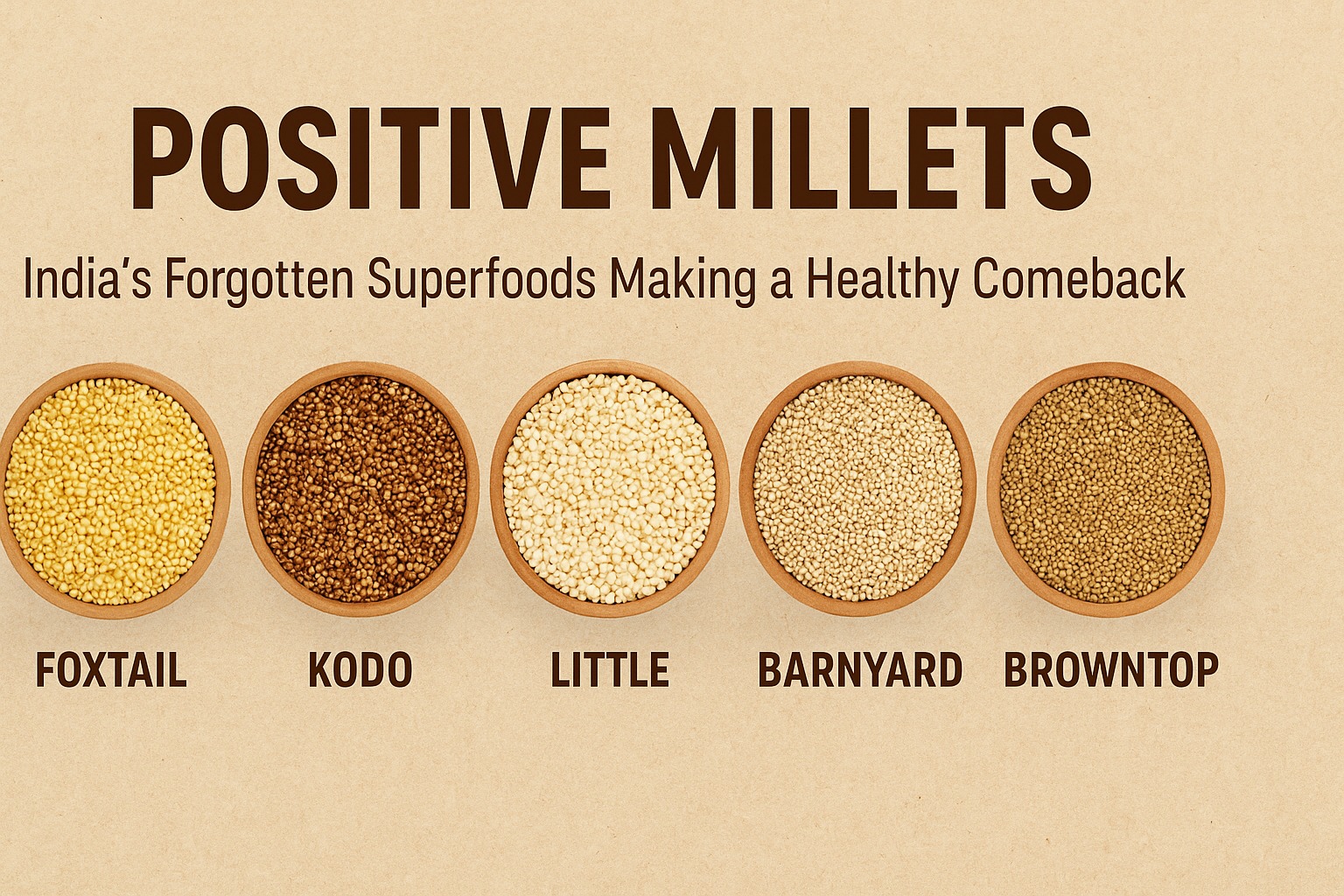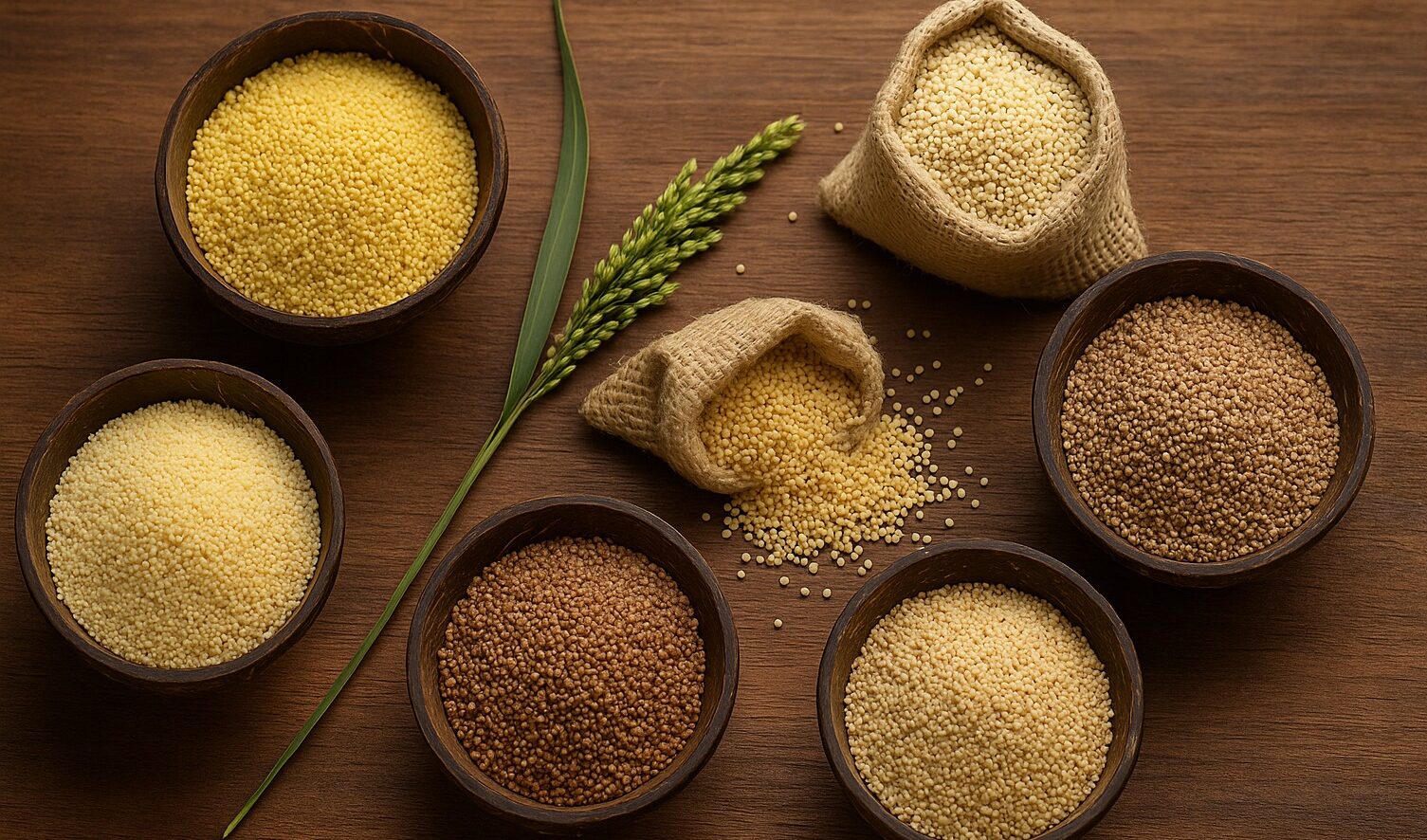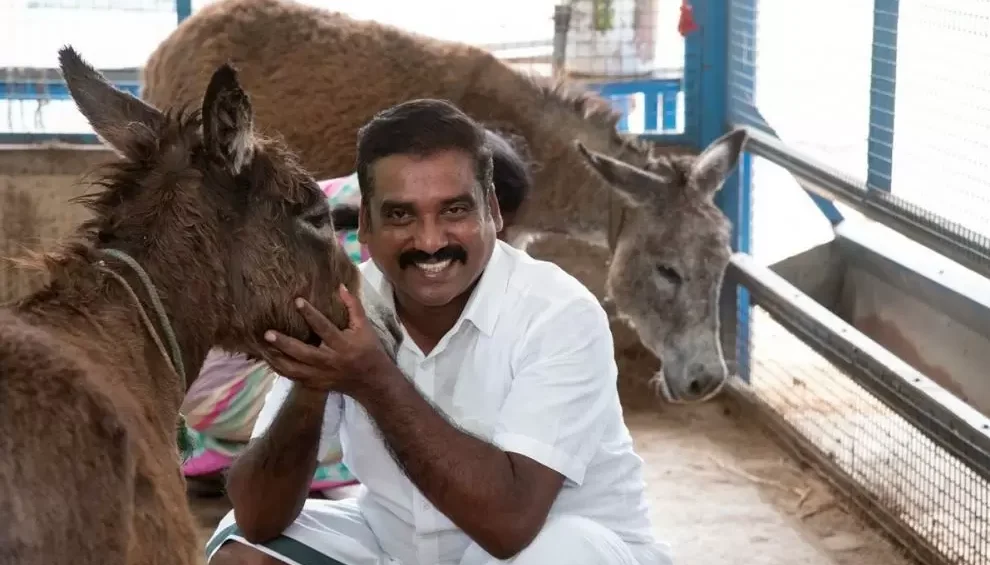For centuries, millets were a staple of the Indian diet, renowned for their resilience and nutrition. But the Green Revolution of the 1960s shifted India’s agriculture towards rice and wheat, relegating positive millets to the status of “orphan crops”. Before that shift, millets comprised around 40% of all cultivated grains in India; today it’s about 20%.
The impact on diets was dramatic, annual per capita millet consumption plummeted from about 30 kg in 1960 to barely 4 kg by 2022. Cheap, subsidized rice and wheat through public distribution, along with changing tastes, meant generations grew up viewing millets as coarse, old-fashioned food.
Now, a resurgence is underway. In recent years the Indian government and agricultural experts have campaigned to bring millets back to plates, highlighting their nutrition and climate resilience. “India is at the forefront of popularising millets, whose consumption furthers nutrition, food security and welfare of farmers,” Prime Minister Narendra Modi declared at a global millet conference in 2023.
The government named 2018 as a “National Year of Millets” and successfully led a UN initiative to declare 2023 the International Year of Millets. Millets have even made diplomatic appearances, from being served at G20 meetings to a millet salad on the White House state dinner menu for PM Modi. This growing spotlight is rekindling interest in what were once India’s most important grains.
Meet the “Millet Man” and the Five Super Grains
Amid this millet revival, one scientist-turned-activist has captured popular imagination with an unusual claim: that not all millets are equal. Dr. Khadar Valli, often called “the Millet Man of India,” classifies food grains into negative, neutral, and positive categories.

Rice and wheat, he says, are “negative grains”, low in fiber and linked to lifestyle diseases. Common millets like sorghum (jowar), pearl millet (bajra), and finger millet (ragi) are “neutral”, better than refined grains but not curing disease. It’s the little-known varieties, which he calls “Siridhanya” (meaning “divine grains” or “wealth grains”), that Dr. Valli touts as “positive millets” for their purported healing powers.
He highlights five in particular: foxtail, kodo, little, barnyard, and browntop millet. According to Dr. Valli’s research, these five “positive millets” are naturally high in fiber (8-12%) and packed with nutrients, and each can help address specific health issues.
“There is a difference. Millet, jowar and ragi are coarse grains. Shreedhanya includes Kodo, Kutki (little millet), Kangni (foxtail), Hari Kangni (browntop), and Sanwa (barnyard). These are all fine grains…being gluten-free and fibrous, these are very beneficial for the body,” Dr. Valli explains.
He and his followers claim that regular consumption of these five millets can prevent or even “cure” a range of ailments, from diabetes and hypertension to thyroid conditions and infertility. Such claims are bold, and medical experts advise treating them with caution, but they have undeniably struck a chord with many Indians seeking natural health remedies.
The Five “Positive Millets” and Their Claimed Benefits:
- Foxtail Millet (Kangni): High in fiber and minerals. Followers say it supports brain and heart health, and Dr. Valli links it to improvements in nervous system disorders like epilepsy and Parkinson’s.
- Kodo Millet (Kodon): Often called a natural blood purifier. Advocates claim it helps manage diabetes, improves digestion, and combats anemia and insomnia.
- Little Millet (Kutki/Shavan): A small grain believed to benefit reproductive health. It’s suggested for issues like PCOD and infertility, and is very easy to digest.
- Barnyard Millet (Sanwa): Rich in iron and fiber, thought to support liver and kidney function and reduce “bad” cholesterol.
- Browntop Millet (Hari Kangni): A rare millet with notably high fiber (~12%). Promoted for weight management and gut health; Dr. Valli associates it with benefits for joint pain, thyroid balance, and skin health.
These claims come largely from traditional knowledge and Dr. Valli’s own field experiences treating patients with millet-centric diets. While rigorous scientific validation is still in progress, nutritionists agree millets are nutritionally superior to polished grains.
According to the Indian Institute of Millets Research (IIMR), most millets contain 7-12% protein, 15-20% dietary fiber, and a wealth of minerals, far more fiber and micronutrients than rice or wheat. They are gluten-free, low on the glycemic index, and rich in antioxidants, which means they digest slower and help regulate blood sugar, a boon for diabetes and heart health.
It’s no wonder millets have been dubbed a “superfood of the future” by Indian officials and scientists.
Millets’ Edge: Climate Resilience and Farmer Economics
Beyond health, a big part of the millet comeback is driven by environmental and economic advantages. Millets are often called “climate-smart” crops for good reason. They thrive in arid zones and poor soils where water-guzzling rice or wheat would fail.
Certain hardy varieties like pearl millet and proso millet can grow with as little as 200 mm (20 cm) of annual rainfall, a fraction of what rice requires. Most millets mature in just 2-3 months, shortening the growing season and water needs.
They are predominantly rainfed, requiring minimal or no irrigation, and can withstand droughts and heatwaves that are becoming increasingly common. As C4 plants, millets use water efficiently and even aid in carbon sequestration, helping soak up atmospheric CO₂.
For farmers, especially in India’s dry regions, these traits are a lifeline. “Millet is a low-investment crop that is rainfed and barely needs inputs such as pesticide and fertiliser,” notes Vijay Jardhar, a septuagenarian farmer in Uttarakhand who has grown millets for 30 years.
Indeed, millets rarely face pest infestations, a fact organic farming advocates highlight, so they can be grown chemical-free without yield loss. This means lower costs on expensive inputs and less damage to soil health.
Agricultural economists point out that millets offer more stable yields under erratic weather, providing insurance against climate shocks. Drought resistance is a major draw: “Even if the [millet] plant shrivels during a drought, it retains the capacity to rebound once it is watered,” observes Dr. Shalander Kumar of ICRISAT (International Crops Research Institute).
Policymakers are taking note of these advantages. Many of India’s top millet-producing states, Rajasthan, Karnataka, Maharashtra, and others, overlap with its most drought-prone zones.
Recognising millets’ role in climate adaptation, the government has increased minimum support prices (MSPs) for millet crops dramatically in the past five years to incentivise farmers. For example, the MSP for common pearl millet (bajra) rose from ₹1,425 per quintal in 2017-18 to ₹2,558 by 2023-24, nearly an 80% jump.

Such policies are bearing fruit: after decades of decline, India’s millet production has edged up again, reaching ~15-17 million tonnes in recent years. In fiscal year 2023-24, India grew an estimated 15.38 million tonnes of millets on 12.19 million hectares of land. This solidifies India as the world’s leading millet producer, accounting for roughly 20% of global output (and 80% of Asia’s).
The Millet Market: From Rural Revival to Urban Plates
As production expands, the push is now on the consumer front, to turn millet farming into a remunerative industry and not just a subsistence pursuit. Traditionally, sorghum, bajra, and ragi dominate India’s millet output (over 70% of it), and much of pearl millet is used as animal fodder.
But the “forgotten” varieties like foxtail, little and browntop, once confined to tribal farms or specialty health stores, are gaining commercial traction. Urban demand for organic and nutrient-dense foods is rising, and millet is reaping the benefits.
The COVID-19 pandemic provided a short-term boost as well, with consumers seeking immunity-boosting foods and rediscovering millets’ value. While overall demand remains modest compared to rice or wheat, there’s clear momentum.
Many Indian households are now blending millets into their daily diet, whether it’s millet flour rotis, dosa batter mixed with ragi, or a bowl of hearty millet porridge for breakfast.
The food industry is also riding this trend. Big food companies and startups alike have begun launching millet-based products, often with government encouragement. “Millets are associated with India’s agricultural heritage and with 2023 being the International Year of Millets, it is only appropriate to bring them to the forefront with suitable product innovations,” says Suresh Narayanan, CEO of Nestle India.
In 2023, Nestlé partnered with IIMR to develop millet supply chains and rolled out new millet-infused offerings, from millet breakfast cereals (incorporating ragi, jowar, and bajra into familiar brands like Koko Krunch) to instant noodles enhanced with sorghum and finger millet.
Its new Millet Masala Porridge mixes bajra with spices to appeal to local tastes.
Other major players like ITC and PepsiCo have announced millet product lines as well, seeing a market opportunity in healthier snacks. According to market analysts, the millet-based foods sector in India is poised for strong growth, with double-digit annual growth rates expected as these ancient grains go modern.
On the ground, a grassroots “millet movement” is taking shape. Small farmers who had abandoned millets are returning to them as demand improves. In the southern state of Karnataka and parts of Telangana and Andhra Pradesh, farmer cooperatives supported by Dr. Khadar Valli’s guidance are cultivating the five Siridhanya millets and selling directly to health-conscious consumers.
In Punjab, an unlikely region for millets, some organic farmers started growing browntop and foxtail millet during the pandemic after hearing of their benefits. “People keep asking me how to grow millets, it has piqued their interest, as everyone wants to boost their immune system,” one such farmer in Punjab told The Tribune.
NGOs and state agencies are holding “Millet Melas” (fairs) to popularize recipes and provide seeds of these crops that had nearly vanished from local fields.
Health Hype or a Holistic Solution?
Millets today carry a double promise: improved public health and climate-friendly agriculture. Early adopters report personal health gains, lower blood sugar, weight loss, improved energy after switching to millets from polished grains.
Doctors, too, are increasingly recommending millets as part of a balanced diet, especially for diabetic or obese patients, given positive millets’ lower glycemic index and high fiber which aids digestion and satiety.
The Indian Council of Medical Research is studying millet-based diets in managing diabetes and heart disease. There is also growing interest in millet’s role in fighting malnutrition.
A recent multi-country study found that replacing rice with millets in meals led to better growth in children, thanks to positive millets’ richer protein, iron, and zinc content.
However, experts caution that millets are not a magic bullet. They should complement other foods, not completely replace staples overnight.
Some millets have anti-nutrients that can affect mineral absorption if not prepared correctly (traditional soaking, roasting or fermenting methods mitigate this).
The government’s challenge is to ensure the millet boom is sustainable, that means developing better processing and storage (millet grains are small and can spoil if not handled properly), and continuing consumer education so that millets don’t fade out once the publicity of International Year of Millets passes.
For now, the trend appears hopeful. What was once derided as the poor man’s food or “coarse grain” is now being celebrated as “Shree Anna”, literally “divine grain” in India’s branding of millets.
From farmers reviving ancient varieties, to entrepreneurs selling millet cookies and pasta, to scientists and chefs experimenting with millet-based diets, the humble grains are staging a comeback.
“Don’t confuse the popular with the powerful,” goes an old saying that millet advocates often repeat. The millets that went out of fashion in favor of modern staples may in fact hold keys to better nutrition and sustainable agriculture.
As India leads a new millet renaissance, these five “positive millets” foxtail, kodo, little, barnyard, and browntop are poised to go from forgotten to forefront in the quest for healthy people and a healthier planet.
Also Read: Mitra’s Rise: Millet-Driven FMCG Innovation from Tier II and III India























